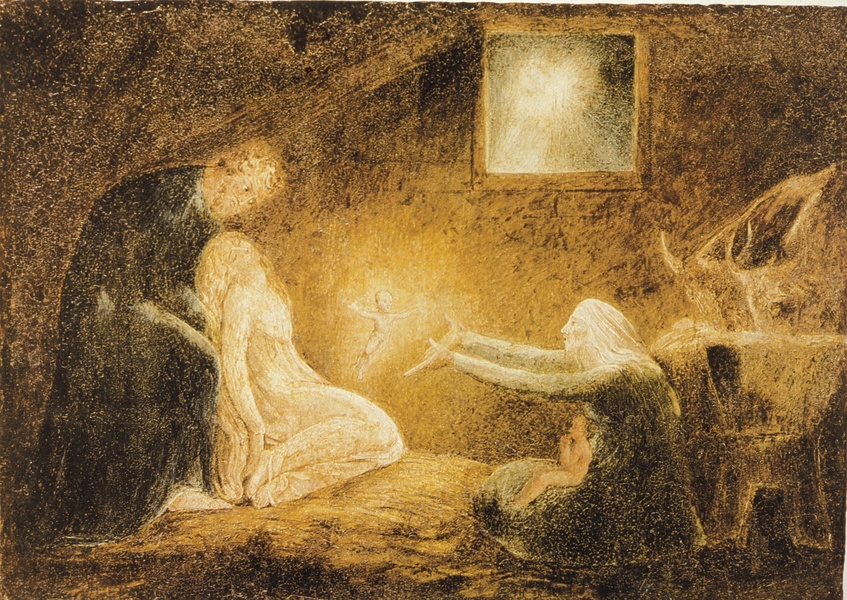In this picture Blake draws on the synoptic gospels, the Gospel of
John and Milton's
Paradise Regained to capture a decisive
instant in the development in the story of Christ. The synoptics
tell us of the temptation of Jesus after his baptism. The Gospel of
John tells of the recognition by John the Baptist and two of his
disciples of Jesus as the Christ, the Son of God. Milton's Paradise
Regained tells of the ambivalence the two disciples felt when Jesus
disappeared from their sight as he entered the wilderness to be
tempted by Satan. The interval when Jesus was temped, Blake shows as
a corresponding event for Andrew and Peter.
The moment between the realisation of Andrew and Peter that Jesus is
the Christ and their committing themselves to follow him was their
struggle with temptation. The spiritual nature of this event is
shown through the two angels who support and encourage the two men.
The call of Christ for followers is not for men to be his corporeal
friends but spiritual friends; to enter into a relationship where
their hearts and minds are laid open to transformation through the
unifying brotherhood of Man with Man, and God with Man.
John 1
[
29] The next day John seeth Jesus coming unto him, and
saith, Behold the Lamb of God, which taketh away the sin of the
world.
[
30] This is he of whom I said, After me cometh a man which
is preferred before me: for he was before me.
[
31] And I knew him not: but that he should be made manifest
to Israel, therefore am I come baptizing with water.
[
32] And John bare record, saying,
I saw the Spirit
descending from heaven like a dove, and it abode upon him.
[
33] And I knew him not: but he that sent me to baptize with
water, the same said unto me, Upon whom thou shalt see the Spirit
descending, and remaining on him, the same is he which baptizeth
with the Holy Ghost.
[
34] And I saw, and bare record that this is the Son of God.
[
35] Again the next day after John stood, and two of his
disciples;
[
36] And looking upon Jesus as he walked, he saith,
Behold
the Lamb of God!
[
37] And the two disciples heard him speak, and
they
followed Jesus.
[
38] Then Jesus turned, and saw them following, and saith
unto them, What seek ye? They said unto him, Rabbi, (which is to
say, being interpreted, Master,) where dwellest thou?
[
39] He saith unto them, Come and see. They came and saw
where he dwelt, and abode with him that day: for it was about the
tenth hour.
[
40]
One of the two which heard John speak, and followed
him, was Andrew, Simon Peter's brother.
[41] He first findeth his own brother Simon,
and saith unto him, We have found the Messias, which is, being
interpreted, the Christ.
[
42] And he brought him to Jesus. And when Jesus beheld him,
he said, Thou art Simon the son of Jona: thou shalt be called
Cephas, which is by interpretation, A stone.
Paradise Regained,
Book II
John Milton
"Meanwhile
the new-
baptiz'd, who
yet
remain'd
At
Jordan with the Baptist, and had seen
Him whom they heard so late expressly
call'd
Jesus Messiah Son of God
declar'd,
And on that high Authority had
believ'd,
And with him
talkt,
and with him
lodg'd, I
mean
Andrew and Simon, famous after known
With others though in Holy Writ not
nam'd,
Now missing him thir
joy so lately found,
So lately found, and so abruptly gone,
Began to doubt, and doubted many days,
And as the days increas'd, increas'd thir doubt:
Sometimes they thought he might be only shewn,
And for a time caught up to God,"
Final lines of
Paradise Regained:
Book IV
"Hail Son of the most High, heir of both worlds,
Queller of Satan, on thy glorious work
Now enter, and begin to save mankind.
Thus they the Son of God our
Saviour
meek
Sung Victor, and, from Heavenly Feast
refresht
Brought on his way with joy;
hee unobserv'd
Home to his Mothers house private
return'd."
Jerusalem, Plate 77, (E 231)
" I know of no other
Christianity and of no other Gospel than the liberty both of body
& mind to exercise the Divine Arts of Imagination.
Imagination the real & eternal World of which this Vegetable
Universe is but a faint shadow & in which we shall live in our
Eternal or Imaginative Bodies, when these Vegetable Mortal Bodies
are no more. The Apostles knew of no other Gospel. What were
all their spiritual gifts? What is the Divine Spirit? is the Holy
Ghost any other than an Intellectual Fountain? What is the
Harvest of the Gospel & its Labours? What is that Talent which it
is a curse to hide? What are the Treasures of Heaven which we are
to lay up for ourselves, are they any other than Mental Studies &
Performances? What are all the Gifts. of the Gospel, are they not
all Mental Gifts? Is God a Spirit who must be worshipped in
Spirit & in Truth and are not the Gifts of the Spirit Every-thing
to Man?"
Descriptive Catalogue, (E 541)
"The Prophets describe what they saw in Vision
as real and existing men whom they saw with their imaginative and
immortal organs; the Apostles the same; the clearer the organ the
more distinct the object. A Spirit and a Vision are not, as the
modern philosophy supposes, a cloudy vapour or a
nothing: they are organized and minutely articulated beyond all
that the mortal and perishing nature can produce."
Milton, Plate 4, (E 98)
"(Mark well my words! Corporeal Friends are Spiritual Enemies)"













.jpg)

